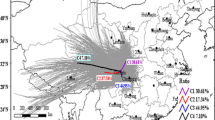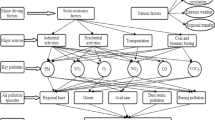Abstract
This paper takes Hohhot as the research area, aiming at the four typical atmospheric pollutants of PM2.5, PM10, SO2, and NOx, and targeting the spatial layout scenarios of different pollution sources. Based on the topological structure analysis method, the CALPUFF model was used to simulate and analyze the linear, divergent, and circular distribution scenarios of pollution sources. ArcGIS and Surfer were used to characterize the diffusion scenarios of four air pollutants under three different spatial structure scenarios and the influence of different spatial structures on the exceeding rate and extreme value of pollutant emissions in small and large regions. A comparison of the results showed that for the small area, the linear distribution of pollution sources has the smallest impact on the environment of the small area by integrating the four pollutants. For the whole region of Hohhot, the residual environmental capacity of PM2.5, PM10, and NOx is the largest under the linear distribution scenario of pollution sources. Considering the residual environmental capacity of the four pollutants, the spatial carrying capacity of the linear distribution scenario of pollution sources is the best for large regions. This paper adopted the method of spatial layout regulation to improve the regional environmental capacity and provided feasible analysis method reference and technical implementation route. Finally, different air pollutant load shedding strategies were proposed according to the distribution characteristics of pollution sources in the study area, providing scientific references and suggestions for different industrial state site selection.

















Similar content being viewed by others
Data availability
The datasets generated and analyzed during the current study are available from the corresponding author on reasonable request.
References
Baek JI, Ban YU (2020) The impacts of urban air pollution emission density on air pollutant concentration based on a panel model. Sustainability 12(20). https://doi.org/10.3390/su12208401
Cetin M, Aljama AMO, Alrabiti OBM, Adiguzel F, Sevik H, Zeren Cetin I (2022) Determination and mapping of regional change of Pb and Cr pollution in Ankara City Center. Water Air Soil Pollut 233(5). https://doi.org/10.1007/s11270-022-05638-1
Cetin M, Onac AK, Sevik H, Sen B (2018) Temporal and regional change of some air pollution parameters in Bursa. Air Qual Atmos Health 12(3):311–316. https://doi.org/10.1007/s11869-018-00657-6
Claessens DPH, Boonstra S, Hofmeyer H (2020) Spatial zoning for better structural topology design and performance. Adv Eng Inf 46. https://doi.org/10.1016/j.aei.2020.101162
Dian C, Pongrácz R, Dezső Z, Bartholy J (2020) Annual and monthly analysis of surface urban heat island intensity with respect to the local climate zones in Budapest. Urban Clim 31. https://doi.org/10.1016/j.uclim.2019.100573
Dong F, Li Y, Gao Y, Zhu J, Qin C, Zhang X (2022a) Energy transition and carbon neutrality: exploring the non-linear impact of renewable energy development on carbon emission efficiency in developed countries. Resour Conserv Recycl 177. https://doi.org/10.1016/j.resconrec.2021.106002
Dong F, Li Y, Li K, Zhu J, Zheng L (2022b) Can smart city construction improve urban ecological total factor energy efficiency in China? Fresh evidence from generalized synthetic control method. Energy 241. https://doi.org/10.1016/j.energy.2021.122909
Eeftens M, Phuleria HC, Meier R, Aguilera I, Corradi E, Davey M, Tsai M-Y (2015) Spatial and temporal variability of ultrafine particles, NO2, PM2.5, PM2.5 absorbance, PM10 and PMcoarse in Swiss study areas. Atmos Environ 111 60-70. https://doi.org/10.1016/j.atmosenv.2015.03.031
Elsunousi AAM, Sevik H, Cetin M, Ozel HB, Ozel HU (2021) Periodical and regional change of particulate matter and CO2 concentration in Misurata. Environ Monit Assess 193(11):707. https://doi.org/10.1007/s10661-021-09478-0
Han L, Zhao J, Gao Y, Gu Z, Xin K, Zhang J (2020) Spatial distribution characteristics of PM2.5 and PM10 in Xi’an City predicted by land use regression models. Sustain Cities Soc 61:102329. https://doi.org/10.1016/j.scs.2020.102329
Holnicki P, Kałuszko A, Trapp W (2016) An urban scale application and validation of the CALPUFF model. Atmos Pollut Res 7(3):393–402. https://doi.org/10.1016/j.apr.2015.10.016
Jung M, Park J, Kim S (2019) Spatial relationships between urban structures and air pollution in Korea. Sustainability 11(2). https://doi.org/10.3390/su11020476
Keshavarzian E, Jin R, Dong K, Kwok KCS, Zhang Y, Zhao M (2020) Effect of pollutant source location on air pollutant dispersion around a high-rise building. Appl Math Model 81:582–602. https://doi.org/10.1016/j.apm.2020.01.019
Li BG, Cao J, Liu WX, Shen WR, Wang XJ, Tao S (2006) Geostatistical analysis and kriging of Hexachlorocyclohexane residues in topsoil from Tianjin, China. Environ Pollut 142(3):567–575. https://doi.org/10.1016/j.envpol.2005.10.039
Li C, Liu M, Hu Y, Zhou R, Huang N, Wu W, Liu C (2020) Spatial distribution characteristics of gaseous pollutants and particulate matter inside a city in the heating season of Northeast China. Sustainable Cit Soc 61. https://doi.org/10.1016/j.scs.2020.102302
Li Y, Rodier C, Lea JD, Harvey J, Kleeman MJ (2021) Improving spatial surrogates for area source emissions inventories in California. Atmos Environ 247. https://doi.org/10.1016/j.atmosenv.2020.117665
Liu K, Xue M, Peng M, Wang C (2020a) Impact of spatial structure of urban agglomeration on carbon emissions: an analysis of the Shandong Peninsula, China. Technol Forecast Soc Change 161. https://doi.org/10.1016/j.techfore.2020.120313
Liu X, Bae J (2018) Urbanization and industrialization impact of CO2 emissions in China. J Clean Prod 172:178–186. https://doi.org/10.1016/j.jclepro.2017.10.156
Liu XJ, Xia SY, Yang Y, Wu JF, Zhou YN, Ren YW (2020) Spatiotemporal dynamics and impacts of socioeconomic and natural conditions on PM2.5 in the Yangtze River Economic Belt. Environ Pollut 263:114569. https://doi.org/10.1016/j.envpol.2020.114569
Liu Y-Y, Barabási A-L (2016) Control principles of complex systems. Rev Mod Phys 88(3). https://doi.org/10.1103/RevModPhys.88.035006
Nebenzal A, Fishbain B, Kendler S (2020) Model-based dense air pollution maps from sparse sensing in multi-source scenarios. Environ Modell Software 128. https://doi.org/10.1016/j.envsoft.2020.104701
Ng WY, Chau CK (2014) A modeling investigation of the impact of street and building configurations on personal air pollutant exposure in isolated deep urban canyons. Sci Total Environ 468–469:429–448. https://doi.org/10.1016/j.scitotenv.2013.08.077
Pan Y, Dong F (2022) Dynamic evolution and driving factors of new energy development: fresh evidence from China. Technol Forecast Soc Change 176. https://doi.org/10.1016/j.techfore.2022.121475
Peng J, Zhang Y, Xie R, Liu Y (2018) Analysis of driving factors on China’s air pollution emissions from the view of critical supply chains. J Clean Prod 203:197–209. https://doi.org/10.1016/j.jclepro.2018.08.219
Ren M, Huang C, Wang X, Hu W, Zhang W (2019) Research on the distribution of pollution-intensive industries and their spatial effects in China. Sustainability 11(19). https://doi.org/10.3390/su11195378
Riasi MS, Yeghiazarian L (2017) Controllability of surface water networks. Water Resour Res 53(12):10450–10464. https://doi.org/10.1002/2017wr020861
Roxon J, Ulm FJ, Pellenq RJM (2020) Urban heat island impact on state residential energy cost and CO2 emissions in the United States. Urban Clim 31. https://doi.org/10.1016/j.uclim.2019.100546
Rui L, Buccolieri R, Gao Z, Gatto E, Ding W (2018) Study of the effect of green quantity and structure on thermal comfort and air quality in an urban-like residential district by ENVI-met modelling. Build Simul 12(2):183–194. https://doi.org/10.1007/s12273-018-0498-9
Shu H, Xiong P-P (2019) Reallocation planning of urban industrial land for structure optimization and emission reduction: a practical analysis of urban agglomeration in China’s Yangtze River Delta. Land Use Policy 81:604–623. https://doi.org/10.1016/j.landusepol.2018.11.034
Stone B Jr (2008) Urban sprawl and air quality in large US cities. J Environ Manage 86(4):688–698. https://doi.org/10.1016/j.jenvman.2006.12.034
Sun S, Li L, Wu Z, Gautam A, Li J, Zhao W (2020) Variation of industrial air pollution emissions based on VIIRS thermal anomaly data. Atmos Res 244. https://doi.org/10.1016/j.atmosres.2020.105021
Xiao XD, Dong L, Yan H, Yang N, Xiong Y (2018) The influence of the spatial characteristics of urban green space on the urban heat island effect in Suzhou Industrial Park. Sustainable Cit Soc 40:428–439. https://doi.org/10.1016/j.scs.2018.04.002
Xu W, Zeng Z, Xu Z, Li X, Chen X, Li X, Zeng G (2020) Public health benefits of optimizing urban industrial land layout - the case of Changsha, China. Environ Pollut 263 114388. https://doi.org/10.1016/j.envpol.2020.114388
Yang H, Song X, Zhang Q (2020) RS&GIS based PM emission inventories of dust sources over a provincial scale: a case study of Henan province, central China. Atmos Environ 225. https://doi.org/10.1016/j.atmosenv.2020.117361
Yuan C, Ng E, Norford LK (2014) Improving air quality in high-density cities by understanding the relationship between air pollutant dispersion and urban morphologies. Build Environ 71:245–258. https://doi.org/10.1016/j.buildenv.2013.10.008
Zhang H, Peng J, Wang R, Zhang J, Yu D (2021) Spatial planning factors that influence CO2 emissions: a systematic literature review. Urban Clim 36. https://doi.org/10.1016/j.uclim.2021.100809
Zhang L, Meng Q, Sun Z, Sun Y (2017) Spatial and temporal analysis of the mitigating effects of industrial relocation on the surface urban heat island over China. ISPRS Int J Geo-Inf 6(4). https://doi.org/10.3390/ijgi6040121
Zhang S, Liu J, Ding H (2018) Research for a novel class of translational spatial multi-loop coupled mechanisms: type synthesis and kinematic analysis. Adv Mech Eng 10(8). https://doi.org/10.1177/1687814018797029
Zhang T, Zang L, Wan Y, Wang W, Zhang Y (2019) Ground-level PM2.5 estimation over urban agglomerations in China with high spatiotemporal resolution based on Himawari-8. Sci Total Environ 676:535–544. https://doi.org/10.1016/j.scitotenv.2019.04.299
Zhang X, Fung JCH, Zhang Y, Lau AKH, Leung KKM, Huang WW (2020) Assessing PM2.5 emissions in 2020: the impacts of integrated emission control policies in China. Environ. Pollut. 263:114575. https://doi.org/10.1016/j.envpol.2020.114575
Zhang Y, Ou C, Chen L, Wu L, Liu J, Wang X, Hang J (2020b) Numerical studies of passive and reactive pollutant dispersion in high-density urban models with various building densities and height variations. Build Environ 177. https://doi.org/10.1016/j.buildenv.2020.106916
Zhao B, Wang SX, Liu H, Xu JY, Fu K, Klimont Z, Amann M (2013) NOx emissions in China: historical trends and future perspectives. Atmos Chem Phys 13(19), 9869-9897. https://doi.org/10.5194/acp-13-9869-2013
Zheng C, Zhao C, Li Y, Wu X, Zhang K, Gao J, Chai F (2018) Spatial and temporal distribution of NO2 and SO2 in Inner Mongolia urban agglomeration obtained from satellite remote sensing and ground observations. Atmos Environ 188 50-59. https://doi.org/10.1016/j.atmosenv.2018.06.029
Zhou H, Jiang M, Huang Y, Wang Q (2021) Directional spatial spillover effects and driving factors of haze pollution in North China Plain. Resour Conserv Recycl 169. https://doi.org/10.1016/j.resconrec.2021.105475
Zhou WY, Xie YX, Zhang J, Deng SH, Shen F, Xiao H, He JS (2020) Estimating the remaining atmospheric environmental capacity using a single-box model in a high pollution risk suburb of Chengdu, China. J Environ Manage 258 110052. https://doi.org/10.1016/j.jenvman.2019.110052
Zhu S, He C, Liu Y (2014) Going green or going away: environmental regulation, economic geography and firms’ strategies in China’s pollution-intensive industries. Geoforum 55:53–65. https://doi.org/10.1016/j.geoforum.2014.05.004
Acknowledgements
This work was supported by Hohhot Ecological Environment Bureau.
Author information
Authors and Affiliations
Contributions
All authors contributed to the study conception and design. Supervision and project administration were performed by [Tianxin Li]. Software, formal analysis, and methodology were performed by [Zichen Li], [Shikun Cheng], and [Xiugui Wang]. The first draft of the manuscript was written by [Anni Zou] and all authors commented on previous versions of the manuscript. All authors read and approved the final manuscript.
Corresponding author
Ethics declarations
Ethics approval
Not applicable.
Consent to participate
Not applicable.
Consent for publication.
Not applicable.
Competing interests
The authors declare no competing interests.
Additional information
Publisher's Note
Springer Nature remains neutral with regard to jurisdictional claims in published maps and institutional affiliations.
Rights and permissions
Springer Nature or its licensor holds exclusive rights to this article under a publishing agreement with the author(s) or other rightsholder(s); author self-archiving of the accepted manuscript version of this article is solely governed by the terms of such publishing agreement and applicable law.
About this article
Cite this article
Li, T., Li, Z., Zou, A. et al. Study of regional air pollutant dispersion scenarios and atmospheric capacity changes based on spatial structure analysis of source intensity—the case of Hohhot, China. Air Qual Atmos Health 16, 127–147 (2023). https://doi.org/10.1007/s11869-022-01262-4
Received:
Accepted:
Published:
Issue Date:
DOI: https://doi.org/10.1007/s11869-022-01262-4




